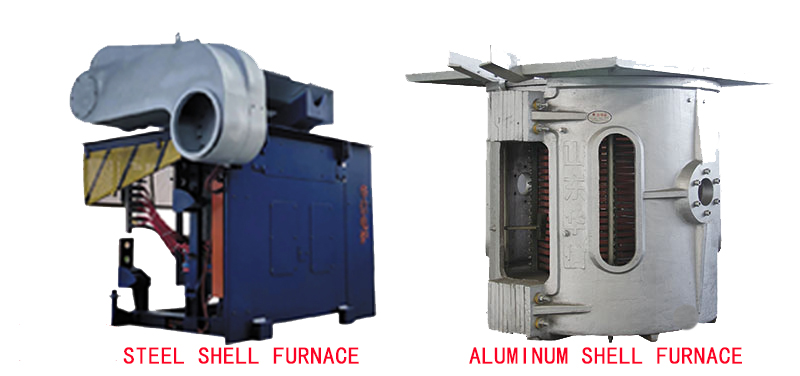The difference between aluminum shell furnace and steel shell furnace
At present, in the intermediate frequency industry, the structure of the intermediate frequency melting furnace is divided into a steel shell with a yoke hydraulic tilting furnace and an aluminum shell with a reducer tilting furnace.

Steel shell furnace:
Has a long life (generally the normal life is more than 10 years),
The stability is good, because the magnetizer is used, the magnetizer has two functions: first, the magnetizer is firmly fixed with the top wire and the induction coil, so that the coil and the magnetizer form a stable structure. Second, the permeable magnet can form a permeable barrier around the coil;
Energy saving, because the furnace with the permeable magnet can save electricity by 3%-5% compared with the aluminum shell furnace;
The casting point is stable, and the hydraulic tilting furnace device can well control the casting angle and speed;
The safety performance is good. Due to the characteristics of the leakage alarm device and the refractory cement layer), the steel shell structure is selected for its good characteristics when the tonnage is greater than 2T.
Aluminum shell furnace:
The aluminum shell furnace is a simple structure with a service life of about 5-8 years. There is no magnetizer, lining ejection mechanism, refractory cement layer, and its safety performance is poor. It is generally used with a capacity below 2T. For example: a set of 5T intermediate frequency furnace, when the furnace is full of molten iron, the overall weight of the equipment reaches 8-10T. If the aluminum shell structure is selected, when the reducer rotates the furnace body to 95 degrees, the entire furnace body will tilt forward, which is very safe. Difference. The aluminum shell furnace is suitable for users who change production in a short time, with small tonnage.
The following is a specific comparison of the advantages and disadvantages of steel shell furnaces and aluminum shell furnaces.
Compared with aluminum shell furnace, steel shell furnace has five advantages:
1) Strong and durable, beautiful and generous, especially the large-capacity furnace body, which requires a strong rigid structure. From the safety point of view of the tilting furnace, try to use a steel shell furnace.
2) The yoke made of silicon steel sheet shields and emits the magnetic field lines generated by the induction coil, reduces magnetic flux leakage, improves thermal efficiency, increases output, and saves about 5%-8%.
3) The existence of the furnace cover reduces the heat loss and improves the safety of the equipment.
4) Long service life, aluminum is oxidized more severely at high temperature, causing fatigue of metal toughness. At the foundry enterprise site, it is often seen that the shell of the aluminum shell furnace that has been used for about one year is in bad condition, and the steel shell furnace has less magnetic flux leakage, and the service life of the equipment is much longer than that of the aluminum shell furnace.
5) The safety performance of the steel shell furnace is much better than that of the aluminum shell furnace. The aluminum shell is easily deformed due to high temperature and heavy pressure during the smelting, and the safety is poor. The steel shell furnace uses hydraulic tilting furnace, which is safe and reliable.
According to industry habits, the aluminum alloy structure supply smelting furnace with the reducer as the tilting furnace is commonly known as the aluminum shell furnace. The induction melting furnace of steel structure with hydraulic cylinder as tilting furnace is commonly known as steel shell furnace.


